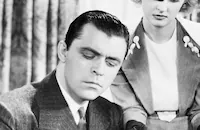No More Orchids

Brief Synopsis
Cast & Crew
Walter Lang
Carole Lombard
Walter Connolly
Louise Closser Hale
Lyle Talbot
C. Aubrey Smith
Photos & Videos
Film Details
Technical Specs

Synopsis
The departure of an ocean liner is delayed pending the arrival of Anne Holt, the daughter of the ship's owner and heiress to the biggest fortune in America. On the cruise, Anne pursues passenger Tony Gage and flirts with him. Knowing Anne is engaged to Prince Carlos, Tony does not believe her when she tells him that she is in love with him. At her home, Anne tells her father Bill, a banker, of her experience, and he invites Tony to dinner. The two men talk most of the evening, but finally the couple is left alone and realize they are in love. Unknown to Anne, Bill is in financial trouble but refuses to go to his father-in-law, Jerome Cedric, for assistance. When Anne visits Cedric, he explains that he financed a revolution to give Carlos a throne and is determined to have them marry, having been thwarted when Anne's mother married Bill rather than Cedric's choice. Cedric tells Anne of Bill's troubles and promises to keep him out of jail only if she marries Carlos. The next day, Anne asks Bill to inform Tony that she will marry Carlos, and Tony bitterly believes she never loved him. Carlos' arrival reveals that he is an inarticulate man well past middle age. Bill, knowing Anne is unhappy, begs Cedric for help but is refused, and realizes he can only save them by removing Cedric's threat. Bill and Gran Holt bring Anne and Tony out to a farm with Judge Terwilliger, who marries them, and Bill calls Cedric to gloat. Then Bill lies to Anne and says he must go to Washington, but crashes his plane and kills himself, ensuring that the ruin he faced will not affect Anne's happiness with Tony.

Director

Walter Lang
Cast

Carole Lombard

Walter Connolly
Louise Closser Hale

Lyle Talbot

C. Aubrey Smith
Allen Vincent
Ruthelma Stevens

Arthur Houseman

William V. Mong
Jameson Thomas
Charles Hills Mailes
Ed Le Saint
William Worthington
Broderick O'farrell
Belle Stoddard Johnstone
Harold Minjir
Sidney Bracy
Crew

Photo Collections
Film Details
Technical Specs

Articles
No More Orchids
No More Orchids was made on loan from Lombard's home studio of Paramount to Columbia. Lombard had just made Virtue (1932) at Columbia, and was a favorite of studio head Harry Cohn, whose salty language matched her own. He was so fond of her, in fact, that he gave her solo star billing in No More Orchids for the first time in her career. According to Screwball: The Life of Carole Lombard, by Larry Swindell, Cohn had suggested that the film be called Roses for Annie, and Lombard replied, "Roses, snapdragons, lilies, call it any flower except orchids - I'm ready for some other angle. No more orchids for me." That was a reference to a Paramount publicity campaign promoting Lombard's alleged fondness for orchids. But Cohn liked the sound of it, and decided it was the perfect title. The phrase also found its way into the film's dialogue, expressing Anne Holt's willingness to give up her rich-girl lifestyle to marry her poor boyfriend.
No More Orchids was the first film Lombard made with director Walter Lang. The film was basically a drama, but Lang recognized that Lombard's witty personality and way with a quip made her a natural for comedy. Her character's entrance in the film takes place after partying in Paris, slightly tipsy, and her slurred "merci" and stumbling exit from the tugboat delivering her to a ship is pure screwball. The film was shot in sequence, and Lang increased the comedy in the film as they went along, so that Lombard's talent could shine. A scene in the ship's gym, with Lombard doing physical comedy, and another sharing witty, affectionate banter with Connolly, are particularly effective. Lombard always gave Lang credit for being the first director to encourage her comic skill, and the two became close friends. He later married Lombard's best friend and assistant Madalynne Fields, known as "Fieldsie." Lombard was their son's godmother. Lang and Lombard would make one more film together, Love Before Breakfast (1936).
Character actor Walter Connolly, a Broadway veteran, had made a couple of silent films, but his film career really began in 1932, when he was signed to a contract by Columbia, where No More Orchids was only his third film. It was also one of the few where he got to play a multifaceted character. He would go on to build a career playing blustery bosses in films such as It Happened One Night (1934) and Nothing Sacred (1937), which also starred Lombard. In addition, they appeared together in Twentieth Century and Lady by Choice (1934). Connolly's untimely death of a stroke came in 1940, at the age of 53, shortly after he played the title role in The Great Victor Herbert (1939).
Variety called No More Orchids "A smart, polished production replete with good acting, smooth direction and clever lines." Mordaunt Hall of the New York Times considered it "an unimportant but entertaining picture." However, it proved to be important in the development of the careers of Lombard, Connolly, and Lang.
Director: Walter Lang
Screenplay: Gertrude Purcell, Keene Thompson from a novel by Grace Perkins
Cinematography: Joseph August
Editor: Jack Dennis
Costume Design: Robert Kalloch
Cast: Carole Lombard (Anne Holt), Walter Connolly (Bill Holt), Louise Closser Hale (Gran Holt), Lyle Talbot (Tony Gage), C. Aubrey Smith (Jerome Cedric), Allen Vincent (Dick), Ruthelma Stevens (Rita), Arthur Houseman (Burkhart), Jameson Thomas (Prince Carlos).
BW-71m.
by Margarita Landazuri














